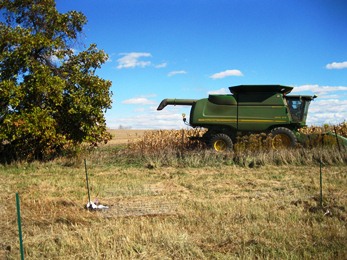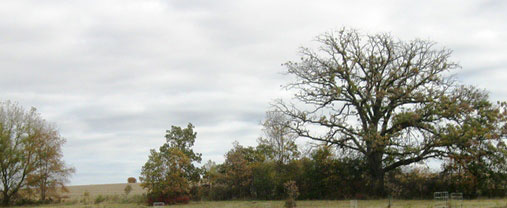
Where, oh where have the hedgerows gone?
 The last year or two, I’ve noticed changes to the farm fields I pass on my commute between Harvard and Woodstock each day. The hedgerows are thinning and in some cases, disappearing altogether.
The last year or two, I’ve noticed changes to the farm fields I pass on my commute between Harvard and Woodstock each day. The hedgerows are thinning and in some cases, disappearing altogether.
As used here, the term hedgerow means a linear strip of vegetation (trees, shrubs and grasses) that runs along the fence line – or property boundary – between fields.
A hedgerow provides a wind break, which in turn reduces the amount of exposed soil that blows off of a farm field each year. It also reduces the amount of blowing a drifting snow, which can be a severe problem along US Route 14 between Harvard and Woodstock.
A hedgerow provides valuable habitat for a diversity of wildlife including deer, fox and birds. A hedgerow provides shelter that allows mammals to pass safely across the landscape and offers insects and birds a place to rest, nest and/or feed.
On some properties, hedgerows are the only place where old oaks are still found. When land was cleared one hundred of more years ago, farmers left many of the trees that were located on or near the property line. Over the years, these trees provided a comfortable spot to have one’s lunch on a hot summer day in the fields. 
So, why are the hedgerows disappearing?
The high price of a bushel of corn.
Just ten years ago, the price of a bushel of corn was less than $3. Now that same bushel of corn sells for more than $6. And that was before the 2012 drought. Farmers are looking for additional land where they can plant corn to maximize production. And at 150-200 bushels an acre yield, even one additional acre of corn will generate $1,000 or more.
Demand for corn is high due in large part to federal Clean Air mandates that require blending ethanol with gasoline to reduce the emission of carbon monoxide. Increased use of ethanol also reduces America’s dependence on imported oil. Both seem worthy causes.
But the world is never that simple, is it? Corn is also needed for livestock feed and has become a staple in American processed food (high-fructose corn syrup, corn starch/baking powder, and corn oil being just a few).
So, basic economics tells us that competition for a product drives up the price, and scarcity (like happened in 2012 because of the drought) will drive up the price even more.
I’ve heard some folks say: “Most of those trees and shrubs are just junk anyway: box elders, buckthorn and honeysuckle.” Sure, but the wind doesn’t pay attention to what tree species is blocking it, and a bird that needs to take a break doesn’t mind if the only resting spot is a honeysuckle bush.
What does matter is whether there is something versus nothing, and the removal of more hedgerows for a few more acres of corn will have an impact on the future productivity of the land and the sustainability of the area for wildlife.
As the soil and birds start to disappear, we all may be wishing those hedgerows were back in place.